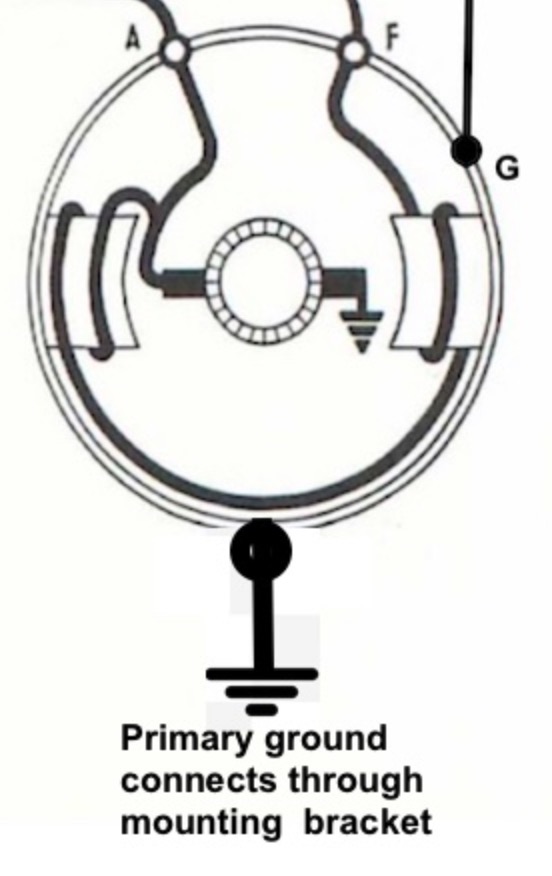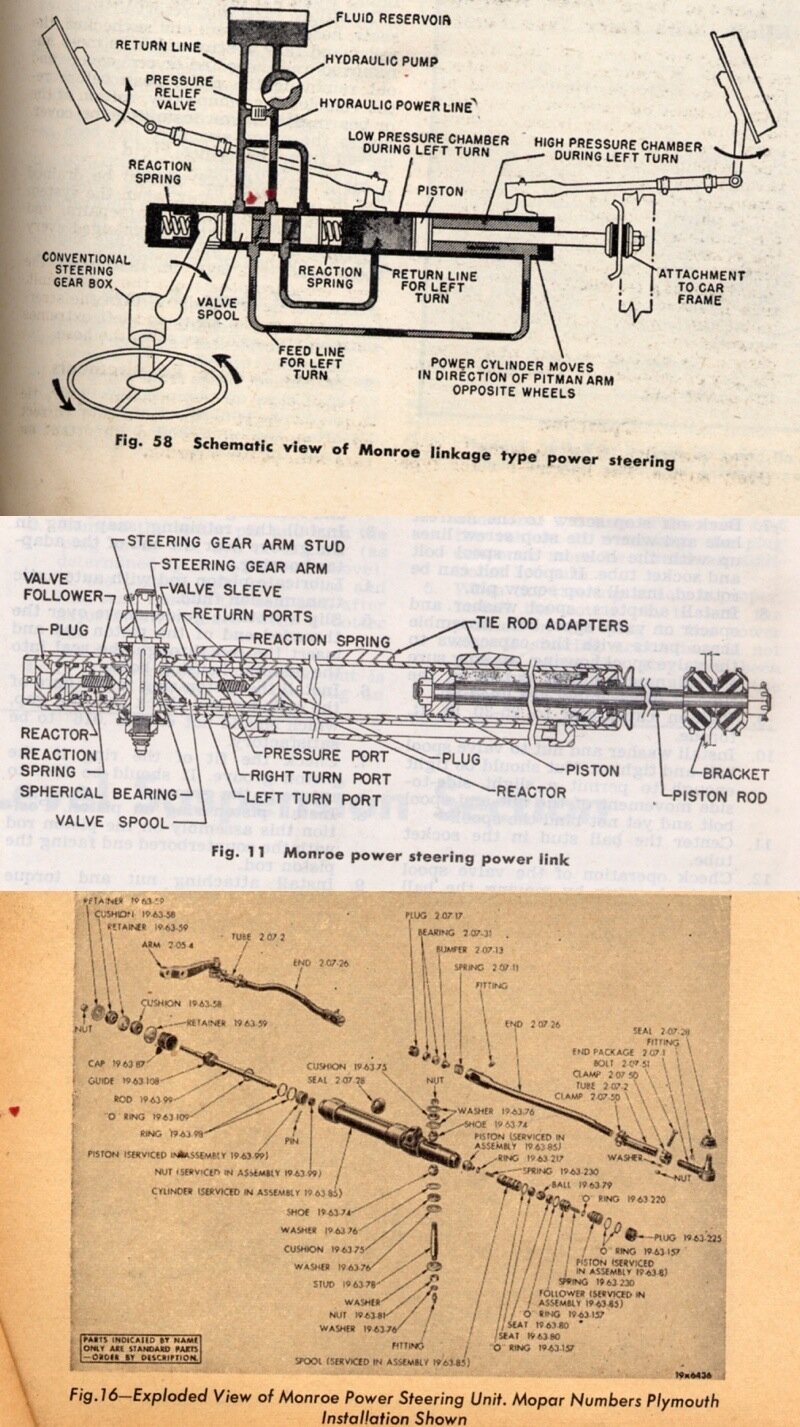|
Re: Don’s 1937 (120) 138CD Deluxe Touring Limo
|
||||
|---|---|---|---|---|
|
Forum Ambassador
|
Others can better answer the pulley question but on a two brush generator, one brush will connect to wiring going to the field coils and A terminal while the other brush will connect to case metal for the ground. If you check carefully where the braided lead from the brush with no other wire connects it is most likely being grounded to the case end plate by the brush holder or where ever the braided lead terminates.
Posted on: 4/6 12:45
|
|||
|
Howard
|
||||
|
||||
|
Re: monroe p/s control valve stud
|
||||
|---|---|---|---|---|
|
Forum Ambassador
|
I don't know if Lares Corporation might have or would even sell individual components or only sell and rebuild complete assys but they do advertise in Hemming's. I believe they have rebuilt steering systems for a few Packard owners who post on the forum. Don't know if other mfgs used exactly the same unit as Packard but Monroe steering was also used on some Plymouth models and their vendors might be worth checking.
Don't remember where this page is from but here is a bit showing Mopar (Plymouth) part numbers. Again, do not know if it exactly the same unit as I believe the typical Packard was heavier and might have had a larger unit than Plymouth.
Posted on: 4/4 17:42
|
|||
|
Howard
|
||||
|
||||
|
Re: Carter carb assistance
|
||||
|---|---|---|---|---|
|
Forum Ambassador
|
I suspect the biggest difference between numbers would be in jet size and adjustments that were specified by the various mfgs engineering depts to be optimized for the engine it was going on.
The correct WDO carb core for your model Packard should be available relatively inexpensively from those on the forum with parts cars or some of our used vendors. If you are handy and a bit mechanically inclined rebuild kits are also easily found. You could probably do something like that for far less than the cost of a professionally done rebuild. Another option which recently came on the market is a replacement universal 2 barrel carb from Daytona Parts. Daytona has been around for years and has done rebuilds for many of us. Their new carb may or may not need some kind of adapter to bolt to the manifold but from the description and the fact it is a new carb it might be worth looking into. I expect the price would be in the same neighborhood as a rebuilt original though. Aside from the visual differences, probably the biggest downside to going with a universal carb is you would need to add a pushbutton to start the engine as the accelerator pedal carb start switch would no longer be there.
Posted on: 4/4 14:35
|
|||
|
Howard
|
||||
|
||||
|
Re: 1937 120 Conv. Sedan - Blanche
|
||||
|---|---|---|---|---|
|
Forum Ambassador
|
Most generators provide the high current ground path to the frame or battery ground connection by virtue of the generator components being connected internally to the generator case. The ground path connection is then provided to the frame or battery by the mounting bracket and bolting hardware. Since the generator is on the engine block and not the frame it is somewhat separated by rubber mounts. Some models with remote battery positions did use a ground strap between the block and frame to get to the battery ground strap.
A small secondary generator ground is only a reference and is usually connected directly to the regulator by virtue of a small gauge wire from a screw on the generator case to either a terminal on the regulator or by connecting to one of the regulator mounting screws. This ground is used only to provide a direct connection to eliminate any potential voltage difference in grounds that might be cause by a poor connection in the mounting bracket or sheetmetal. This reference is needed so the regulator knows exactly what voltage the generator is producing without any added resistance due to a poor metal to metal connection. It is not designed to carry any high current such as that needed to operate the starter or headlights etc. A heavy ground strap or wire from the generator is not used on any Packards I have seen but it certainly would not hurt if you wanted to add something like a short braided strap between the generator mounting ear to the frame.
Posted on: 4/4 11:37
|
|||
|
Howard
|
||||
|
||||
|
Re: 1937 120 Conv. Sedan - Blanche
|
||||
|---|---|---|---|---|
|
Forum Ambassador
|
If you kept the relay with fuses which was assumed to be powering the sealed beam conversion make sure it is getting power and that the dimmer switch is actually turning on the relays. If you are using a stock harness and the headlight switch with city, county, pass combinations for headlights then you may need to chase wires and modify connections to eliminate some of the combinations.
Since the turn signals were not offered on 37 models it is hard to guess what might be going on without seeing a diagram of what must be an aftermarket item. There were several brands but if you can find a mfg or model a diagram might be found on the web. Horns get power from the BAT post on starter solenoid to power the relay which operate the horns. The command is a ground from the horn button. Most cars have an inline connecter at the base of the steering box to join the wire from the button to the loom so if your car has one make sure there is a good connection with wire from button to the loom and it continues on to the relay.
Posted on: 4/3 18:16
|
|||
|
Howard
|
||||
|
||||
|
Re: 1951 200 Deluxe Sedan
|
||||
|---|---|---|---|---|
|
Forum Ambassador
|
Quote:
Quote:
If Eaton cannot help or does not have anything in your price range and you want to see if you can find something else that might fit, the specs (length, width, load & spring rate) for the 51 200 rear springs are on page 33 in Vol 24 #8 August 1950 issue of the Service Counselor.
Posted on: 4/2 21:05
|
|||
|
Howard
|
||||
|
||||
|
Re: BigKev's 1937 115-C Convertible Coupe
|
||||
|---|---|---|---|---|
|
Forum Ambassador
|
As I remember the later seals the slit is there not so much for binding but so you can slide it over the rod. IIRC the hole is just a slight bit larger than the rod and ball is too large for the hole
Posted on: 4/2 14:02
|
|||
|
Howard
|
||||
|
||||
|
Re: BigKev's 1937 115-C Convertible Coupe
|
||||
|---|---|---|---|---|
|
Forum Ambassador
|
Many of the postwar cars also had a rubber accelerator boot or bellows that worked in conjunction with the fiber piece to better provide a dust and fume seal. You are correct that the hard fiber is not the most effective seal ever made but then neither were the rubber brake pedal and clutch arm seals. Most of those seemed to deteriorate or break at the tiny bellows portion with the flat sealing part that did the work falling off or pushed down away from the floor hole. Those seals let in larger amounts of air and fumes whenever a pedal was depressed than the tiny bit of slop in the fiber surrounding the accelerator rod..
Posted on: 4/2 13:42
|
|||
|
Howard
|
||||
|
||||
|
Re: BigKev's 1937 115-C Convertible Coupe
|
||||
|---|---|---|---|---|
|
Forum Ambassador
|
On the washer like dust seal in post 1407, a similar or maybe the same item was used on some postwar models. Those are a hard compressed fiber piece about 1/16 thick which on cars I have seen is not glued but rather free floats between the metal floor and rubber mat or carpet. The weight of the floor covering holds it close to the floor but allows slight movement to follow any changes in the rod angle.
Posted on: 4/2 11:43
|
|||
|
Howard
|
||||
|
||||

 generator.jpg (61.08 KB)
generator.jpg (61.08 KB)








